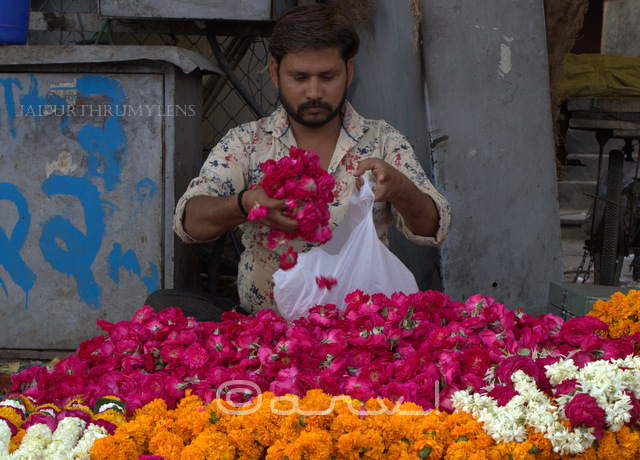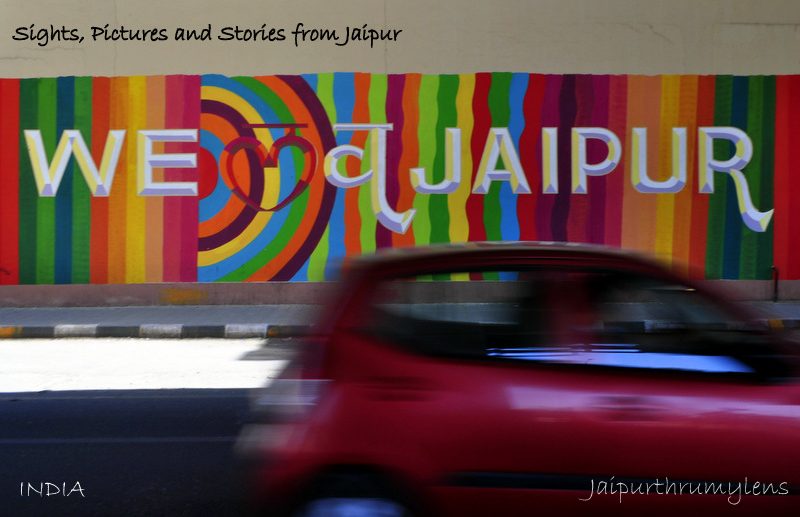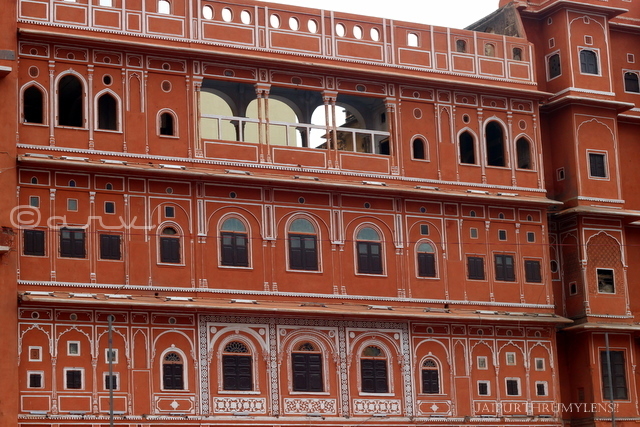Walking tours are a perfect way to discover the city. Over the last few years, heritage and cultural walking tours have become extremely popular. Why so? There are a variety of Jaipur walking tours, from heritage walking tours Jaipur to cultural walking tours Jaipur local markets in the old city of Jaipur. These Jaipur walking tours allow one to see things differently, an invaluable opportunity to witness life in Jaipur, closely. In recent times, some tour operators have been offering a free walking tour in Jaipur. Are Free Walking Tours in Jaipur really free? Most “Free Walking Tour Jaipur” come with an expectation of a tip. So how can one do a “Free Walking Tour Jaipur”? Recently, a walk leader shared his experience when he met with a traveler who ended up wasting his time as no one turned up at the appointed time after registering for a free walking tour in Jaipur on one of the leading travel websites. The walk leader was conducting a guided Jaipur walking tour when this traveler sought his help; he was unable to find the contact of the free walking tour in Jaipur that he registered for. Unfortunately, the traveler ended up wasting his time as no one turned up for the “Walking Tour Jaipur”. This is only one such case. Here is all that you need to know about the Jaipur free self-guided walking tour.
How To Do A Free Walking Tour In Jaipur? Jaipur Self-Guided Walking Tour
Having explored Jaipur considerably during the last few years, I have had the opportunity to lead Jaipur walking tours or heritage walks in Jaipur for travelers, academicians, and students from across the world. I’m sharing a free walking tour in Jaipur; this Jaipur self-guided walking tour doesn’t require a guide. This free Jaipur walking tour allows one to experience Jaipur on your own, at your own pace.

Free walking tours are common in Europe and replicated across other parts of the world, especially in notable tourist towns. After undertaking a couple of free and paid walking tours, I feel the term “free walking tour” is a misnomer. The guide at some point will notify you that it’s a tip-based walking tour and also disclose how much you should tip. In a way, the term “free” is a trap. If a guided walk is advertised as a free walking tour it should be free and not come with the expectation of tips. Sandeman’s New Europe Walking Tours clearly mentions tours are free and tips are complimentary. Sandeman’s walking tours are amazingly popular and highly recommended if you are visiting Europe. I feel it is fair to compensate someone for their knowledge and time; nothing is free in this world.

Please note that it is impossible to provide entire details in one blog post. This heritage walk in Jaipur only provides a framework to explore on your own without the need for a guide in Jaipur. Therefore, in no way, the Jaipur self-guided walking tour is an exhaustive guide for travelers rather it offers a synopsis of the Jaipur walled city. You can save the free walking tour Jaipur route map on Google Maps located at the bottom of this post.

Free Walking Tour Jaipur Route & Information | Self-Guided walk
Here is a route map for a Free Walking Tour Jaipur with reference points.
- New Gate

New Gate is one of the nine gates of Jaipur’s walled city area. This was the last gate to be built in the 1940s hence named New Gate. This gate was built to connect the new upcoming areas with the old walled city area. In comparison to other gates, this gate follows straight lines and draws inspiration from the gates built during those times.
Read more about Jaipur Gates in Old Gates of Jaipur
- Bapu Bazaar
From New Gate, take a right turn, and walk through the Bapu Bazaar towards Sanganeri Gate.

Bapu Bazaar remains a thriving market and is quite popular among travelers and tourists for shopping. This market is well known for the Sanganeri print fabrics – bed sheets, suits, jackets, and Mojari /Jutis.

Pro Tip: It is a good market to buy clothes, handmade local footwear -Mojadis and Chappals, and Sanganeri block-printed furnishings.
Read Jaipuri Jutis


- Sanganeri Gate

Sanganeri Gate is one of the most famous gates of Jaipur because it leads to Johari Bazaar, the most popular market for shopping in Jaipur.
Read more about Sanganeri Gate in the Old Gates of Jaipur
- Johari Bazaar


The beauty of Johari Bazaar, one of Jaipur’s old markets is its appeal among locals and travelers alike. This is where the famous Jaipur jewelry is manufactured and sold. Jaipur is a well-known trading & manufacturing hub for colored stone jewelry as well as Kundan Meena, Polki, and Jadau Jewelry.

There are thousands of jewelry manufacturers and traders in the Johari Bazaar. Apart from jewelry, there are many shops selling garments, handicrafts, artificial jewelry, dry fruits, masalas, and whatnot? Johari Bazaar is one of the most popular places for wedding shopping, especially for jewelry and clothes.
To have a better look at Sanganeri Gate, take a right turn from Bapu Bazaar through the small gates and walk out to receive a glimpse of Sanganeri Gate in its full glory.

- Sanganeri Gate Hanuman Ji temple
Once done, retrace and walk through the gate back into the market, head straight towards the North direction until you discover a temple on your left – the Hanuman Ji temple of Sanganeri Gate.

As per legends, the temple is ancient; some claim it to be older than the city. It retains no signs of antiquity and is all modern in its construction. It enjoys a substantial following and Tuesday draws thousands of devotees. There’s another temple on the opposite side – Shree Roopchandrama Ji Temple. It has beautiful architecture. Sadly, it doesn’t attract many devotees anymore.

From the temple walk towards the north until you find this gate on your right. Traverse the road towards the other side into the gate.
- Fruit and vegetable market in Johri Bazaar

A few more steps and you are in a local vegetable market of Johari Bazaar. Walk around to witness how vegetables have been sold for decades. Supermarkets still haven’t been able to replace the way people buy fruits and vegetables in Jaipur much like many ancient cities across the world like Cairo or Fez.


The locals like to buy directly from the sellers and prefer to bargain and choose from a variety of sellers. You might want to strike up a conversation with one of the vendors and maybe purchase something. They are inexpensive in comparison to Europe, the USA, or even Singapore, and Hong Kong. A kilogram of Banana will cost USD 0.50!

- Johri Bazaar Market Shops
After exploring this market, walk out through the second exit which is devoid of a gate. Once you are out of this market, take a right turn towards the north and walk through the covered walkway in front of the shop facade. This walkway is designed to provide respite from the sun and rain for the shoppers.

As you walk from the vegetable market, you will find a variety of shops selling food items that are a mainstay of the Indian kitchen like grains and spices. These shops have been selling in the same manner for decades.



Many changes have taken place, though. Previously the shop shutters were made of wooden doors but now the rolling metal shutters have replaced them.

You can find one in Johari Bazaar near shop number 79 on your left-hand side. Here is a picture for your reference.

There are a total of four lanes on your right side and four on your left. Jaipur is a planned city and all lanes intersect at a right angle. This walk covers the ones on your right side.
The first one is the KGB (Kundiger Bhairon Ji) Ka Rasta, followed by MSB (Moti Singh Bhomiyan) Ka Rasta, Ghee Walon Ka Rasta, and Haldion Ka Rasta.

Once you come across the third lane, Ghee Walon Ka Rasta, enter this street.
- Ghee Walon Ka Rasta

You will find many shops selling sweets and savories at the start of Ghee Walon Ka Rasta. These shops are extremely popular among the locals and worth trying a few offerings. You can also try a few Indian sweet delicacies like Malpua.

Sambhar Fini is an enormously popular shop to try local sweets – Ghevar and Fini.
Pro Tip: For travelers visiting from the western hemisphere eating street food may not be a good idea if your gut is not acclimatized. Delhi Belly can give you a tough time.


Keep walking in this lane until you come across this Jain temple at a crossing. The temple is a prominent Jain temple in Jaipur belonging to the Shwetmber sect of Jainism called Sri Suparasnath Bada Jain Temple.
Do note that the temples are religious places and not tourist attractions. Many Jain temples in Jaipur do not permit visitors other than followers due to strict religious practices. Like all temples in India, dress and footwear codes need to be followed for a temple visit. Walking in a Jain temple is not always a good idea.
You can check out one of the biggest Jain temples in Jaipur, still in the making- Arihant Vatika.
Here is a picture from another Shwetamber Jain temple in Jaipur and from the temple mentioned above.

Read Arihant Vatika Shwetamber Jain Temple at Mohanbari Jaipur

Jain Temples in Jaipur are not tourist places
Take note of the facades of old houses on this street. Traditional Rajasthani big mansions are called Havelis and are characterized by beautiful paintings and doors. Read more about Havelis in Jaipur

Not all houses and doors feature detailed and colorful paintings, some are simpler yet beautiful.

Take the left from this temple to proceed in the north direction. This market is called Dara Bazar and there are innumerable shops selling clothes and fabrics. It is a buzzing market. There’s another Jain temple belonging to the Digamber Jains in Jaipur.

After walking a few meters, you will come across an intersection of the fourth lane- Haldion Ka Rasta. Turn left and walk towards the Johari Bazaar.
- Haldion Ka Rasta


This market was traditionally a market for jewelry. In recent times, many modern shops have come up selling a variety of items. In the old days, some of the noted Jaipur jewelers were based in Haldion Ka Rasta.

After reaching Johari Bazar, turn right and continue on the covered walkway. The shops on your right are primarily selling jewelry, garments, and Saris. You will find many street vendors selling junk jewelry and colored stones.


Continue towards Badi Chaupar, a big square with an intersection. Badi Chauper area is chaotic due to merging traffic.
- Jaipur Flower Market at Badi Chaupar
You will come across a flower market on your right at Badi Chaupar. Many refer to this as a Jaipur Flower Market. The flower vendors have been selling fresh flowers for many decades. There is a bigger Jaipur Flower Market close by. Many devotees buy flowers on the way to their customary visit to the temple.


From Badi Chaupar it is easy to locate Hawa Mahal in the northwest direction. Walk towards Hawa Mahal.
- Hawa Mahal and Sireh Deori Bazaar

The shops in front of Hawa Mahal cater to tourists with a variety of merchandise. Quite likely, you will be invited to inspect the goods sold in the shops by the staff. This is not the best place to buy good quality products.

Continue on the same road until you come across this building on your left which was previously a town hall called Sawai Man Singh Town Hall. It is a defunct building and is out of use presently.

Cross over to the other side of the road and walk towards the north until you find this gate on your left called Sireh Deori Gate. Turn left and walk through this gate.
- Sireh Deori Gate

- City Palace Compound
Towards your left will be a few grain sellers and a pigeon feeding point. It’s a favorite spot among travelers to click pictures for Instagram and social media.

Continue walking on the same road and walk through the Nakkarkhana Gate. We are walking towards the city palace compound and this is the first gate you will encounter.
- Nakkarkhana Gate

Soon, you will come across a large public square called Jaleb Chowk. Currently, it is a neglected space and many sections have fallen out due to disrepair.
- Jaleb Chowk in Jaipur City Palace Compound

From here turn right and walk through a gate towards the Govind Dev Ji Temple. You will find many devotees headed toward the temple. The temple is open throughout the day but the Darshan can only be done during the predesignated slots. Some slots are more popular and hence more crowded. The timings of the slots can be checked online on the portal of the temple – govinddevji.net.
- Govind Dev Ji Temple
As in any temple in India, you need to remove footwear before entering the temple; you will find a shoe stand on the right. Usually, a volunteer will ensure the safekeeping of the shoes; though tipping is not mandatory, it ensures a good service; Rs 10 is good enough. It is a historic temple and the rulers of Jaipur consider Govind Dev Ji as their Isht Devta


This free walking tour in Jaipur ends here. You can continue to explore Jaipur City Palace or Jantar Mantar from here. Both these tourist attractions are in the vicinity.
Map | Free Jaipur Walking Tour
This free Jaipur walking tour covers the Walled City Area, a UNESCO World Heritage site. It was awarded UNESCO World Heritage Site status in July 2019. Here is a free walking tour map.
If you want to get a shareable Google map along with markers and pictures of the places, kindly reach out to me via the contact form on this blog.

How much time is required to complete this Free Self-Guided walking tour in Jaipur?
The estimated time to complete this walking tour in Jaipur is 1.5-2 hours but you can always fine-tune it depending on your interests. Photography enthusiasts and people who love exploring cultures tend to take considerably longer.
What to expect in this Free Self-Guided Jaipur Walking Tour?
It is a good idea to understand what Glimpses from everyday life, beautiful heritage architecture, a busy bazaar scene, and a variety of smells and sounds! These are the few elements of this free Jaipur walking tour.

Vernacular Jaipur Architecture on the Jaipur Walking Tour Route
Here are a few not-to-be-missed buildings built in the Jaipur vernacular architectural style on the main street of Johari Bazaar during this walking tour in Jaipur.
Deori Ji Temple in Johari Bazaar
This is on the right side (East) of the bazaar

Kothari Bhawan
This is on the left side (West) of the bazaar

The murals and paintings on the exteriors are part of the restoration process; originally this wasn’t in this form and has been redone.

The walled city is undergoing a drastic change. Many old buildings are being razed down to be replaced by new construction. Often old exists in harmony with modern architecture.
LMB Sweets & Hotel
These are modern structures that have replaced the old facade. One of the most prominent is LMB sweets. Notice how this building’s architecture & color look out of place.

Another example of how new construction cannot replace the old building can be seen in this picture.

Is Jaipur Walkable?
The walled city of Jaipur is one of the best places to walk in Jaipur because it offers a lot to see. It is certainly walkable considering short distances. However, do watch out for bikes and other traffic hazards; people generally don’t always observe universal traffic rules. Watch where you place your foot, the narrow streets in this old part of Jaipur, are not the cleanest places that you might have seen especially during the rule of current Congress party rule.

Is It Safe To Walk Around in Walking Tour Jaipur?
It is generally safe to walk on a “Walking Tour Jaipur” through the route mentioned in this blog during the daytime. I always recommend people use their judgment when it comes to safety. If you have a feeling that it is unsafe to walk alone, don’t override! In such a case, it is better to go for a guided walking tour because the walk leader understands the locality and situation. When undertaking a “Walking Tour Jaipur” dress conservatively. The tourist attractions in Jaipur are generally safe, avoid venturing into an unknown area before checking with a reliable local source like your hotel.
History of Johari Bazaar

Johari Bazaar is one of the most popular bazaars in the old part of Jaipur and certainly the most historic. It is one of the originally planned bazaars of the pink city.

The shops have a covered walkway meant to provide shade whereas the roof served as a viewing deck for the public. Historians claim that the colonnaded walkway was built during the reign of the last ruler of Jaipur. Many religious processions used to pass through Johari Bazaar. Shopping in Jaipur is incomplete without a visit to Johari Bazaar.
Self-Guided Walking Tours In Jaipur Vs Free Guided Walking Tours Vs Paid Walking Tours in Jaipur. Which one to take?
Is a Jaipur self-guided walking tour better than a guided Jaipur walking tour? Like everything else, a self-guided tour has its own limitations. For one, you need to be good at navigation. Despite a good well-marked map, many travelers are uncomfortable using one. Also, for people visiting from quiet places, a buzzing Indian bazaar is a “sensory” attack. There’s so much noise, a variety of smells, overcrowded streets, and lastly, too many things happening all at once. This can be an overwhelming experience for many travelers.

This is a reason why a large number of travelers prefer Jaipur guided walking tours with a walk leader. It allows them to relax and just soak in the atmosphere rather than worry about navigation, traffic, and route maps. As an added bonus, the walk leader of the walking tour also acts as a translator. For others, exploration is an adventure. They enjoy getting lost and finding something new which was not mentioned in their guide. Read more about a Guided Heritage walk in Jaipur.

Many people miss the conversation and exchange of ideas that come with a guided tour. Travelers will likely have many questions and a Jaipur self-guided walking tour offers no opportunity for answers. Jaipur markets are buzzing and a self-guided walk is not a complete answer for the inquisitive ones. Find out more about the guided walking tour – Heritage walking tour in Jaipur

There are many “hidden places in Jaipur” that cannot be explored with a self-guided walking tour in Jaipur. There’s so much to see and experience like this old Haveli in the walled city. The narratives and stories are best experienced with a walk leader. Love stories from the Jaipur walled city? Check out Sunday

Self-guided walking tours are best for people who love exploring at their own pace. Also, guided walks often operate at a pre-decided time, a self-guided walking tour allows one to choose the most convenient time. It works very well with photographers and artists who need more time. Guided walks tend to rush through the route and often lead unsuspecting travelers into buying overpriced local merchandise. This is a common ploy employed by guides across the world. There are some variations as well, in some cases guides make a pitstop at an overpriced cafe/eaterie. Jaipur is no exception and this is true for even well-established walking tour operators who have been in this industry for many years. This practice needs to end. Read more about a Guided Heritage walk in Jaipur
What do you think? Do you have any experience with Jaipur walking tours to share? Questions or comments on A Walking Tour in Jaipur? Reach out to me Jaipurthrumylens at Gmail com.
If you enjoyed reading this post, don’t forget to share it on your social media.

Follow me on Facebook Twitter Instagram
Pin it for later




A very detailed and interesting guide who remotely immersed me in the identity and culture of India. I enjoyed reading it. Unfortunately, I have never been to this amazing country.
LikeLiked by 2 people
Looks like we already visited Jaipur after this extensive post. Lovely pictures!
LikeLiked by 2 people
I’m glad you enjoyed this virtual tour of the walled city area in Jaipur. Have you ever been to Jaipur, Smitha?
LikeLike
nice pictures along with the write up…..
LikeLiked by 2 people
I’m glad you liked it, Amit
LikeLike
Arv, During a time when we cannot travel due to the pandemic, your post with all its details and photos makes me feel that I got to travel around Jaipur on a mini tour!
We had been to Jaipur many years ago but after reading your post i want to go again.
LikeLiked by 2 people
I’m glad this post helped you with a virtual travel break, sandhya. Jaipur is incredibly popular among travelers and people love visiting this city, again & again. I’m hoping you get to visit this city very soon. 🙂
Thanks for sharing your thoughts.
LikeLiked by 1 person
WOW!! This is such a blockbuster post! It has everything that tourists who like to explore would like to experience. From Jutis to Vegetable markets to jewellery and on and on it goes. I can’t even imagine how much beneficial it will be to so many. Kudos to you for having the patience to outline the framework with this much detailing. Thank you so much!
LikeLiked by 2 people
I’m sure, they will. 😊 It does take time to document such post. I’m glad you understand this, Neel. I also feel this’ll benefit curious travelers like you. Thanks for sharing your thoughts. 😊
LikeLiked by 1 person
You forget about some other beautiful places like Jhalana Safari, Shila Devi, and more…
LikeLiked by 1 person
Hi Ekta, the places you mentioned cannot be covered by foot and are not in this route. One would need vehicle to reach these places.
LikeLike